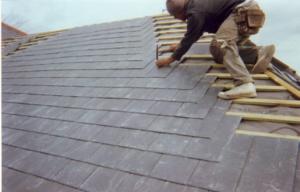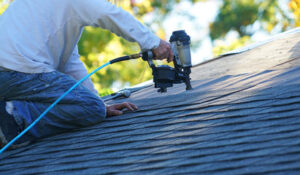A roofer is a person who builds or repairs buildings’ roofs. They usually work as crew members for roofing contractors and need to attend training every year.
He was conned by a fake roofer who pretended to be the boss of a firm working on his terraced home in Cleckheaton. Click https://bluespruceexteriors.com/ to learn more.

Roofing contractors build, repair, replace, and maintain roofs for buildings. They use various materials, including traditional and solar shingles, slate, wood, aluminum, etc. They also install drainage systems, aeration, and waterproof membranes. Often, they also provide layers of vegetation and soil for green roofs. These roofs provide insulation, reduce stormwater runoff, and improve energy efficiency. Roofers take detailed measurements to calculate material needs as part of their job. They also read blueprints and diagrams to follow job instructions. Because roofers work on top of structures, they need to be able to climb and bend for long periods in extreme weather conditions.
To become a roofer, you need a high school diploma or GED certificate. You can then pursue a four-year apprenticeship program that includes on-the-job training and technical training, as well as hands-on experience in the field. After completing the apprenticeship, you will be eligible for certification as a journeyperson roofer.
In addition to the skills you learn as an apprentice, you must have good customer service skills. Since roofers routinely visit other people’s homes, they must be polite and respectful. They must be able to sustain good relationships with clients and other contractors and effectively guarantee that all safety standards are followed at all times.
As a roofer, your duties include installing, repairing, and replacing residential and commercial roofs. You can also repair walls, ceilings, floors, and gutters as part of your work. Other tasks may include insulating and damp-proofing walls, floors, and roofs. You can use various tools to carry out these tasks, including sprayers, power and hand tools, air compressors, and heaters. You can even paint or apply textured finishes. You can also repair and resurface gutters, drainpipes, and hoppers. You can also bind and seal roof openings and install and resurface shingles and tiles. You can also resurface the roofs of other structures, such as garages, sheds, and conservatories.
Education and Training Requirements
A roof is a vital part of any building, protecting everything inside. Whether it’s homes, offices, or hospitals, we all depend on them for shelter and security. Roofers are essential in maintaining these structures, which is why they need the right skills and training to perform their duties safely.
Those who wish to become roofers must earn a high school diploma or equivalent and enroll in trade school. They can also pursue an apprenticeship, which allows them to earn a salary while learning the trade. These apprenticeships can last anywhere from two to three years.
After completing an apprenticeship, new roofers are placed with experienced roofing contractors. They start by helping with basic tasks such as carrying equipment and erecting scaffolding. Once they’ve learned the basics, they can complete more complex tasks and work with various materials.
In most states, a roofer must pass a construction supervisor license exam to be licensed to operate in the industry. They must also register with the state and provide proof of insurance and a surety bond.
A career as a roofer is ideal for detail-oriented people who enjoy working outdoors and don’t mind climbing to heights. It also requires physical fitness and exceptional hand-eye coordination. In addition to these skills, a roofer must have a strong knowledge of safety regulations and technical plans.
Working Conditions
Many roofers are peripatetic, traveling between different sites throughout the week. They must be aware of the potential for road traffic accidents and take suitable precautions. If they are using mobile access equipment such as tower scaffolds, stair towers, or ladders, their maintenance and safe use are crucial. A third of all fall-from-height accidents involve these types of equipment, so anyone erecting or using them must be trained and competent.
Solvents and other chemical products used in roofing are highly flammable and must be stored securely. They can also cause harm if inhaled, especially if the fumes contain polyaromatic hydrocarbons or particulates. According to the Dangerous Substances and Explosive Atmospheres Regulations 2002 or Control of Substances Hazardous to Health (COSHH), these substances should only be handled after a risk assessment has been carried out and appropriate control measures have been put in place.
If working on older buildings, they may be exposed to asbestos, which is highly toxic and can cause respiratory illnesses such as cancer, lung disease, and asthma. It is estimated that 5,000 trade workers die each year from asbestos exposure.
Roofers can be particularly vulnerable to a repetitive strain injury, which affects the upper body muscles, including the arms, wrists, hands, fingers, and neck. Frequent posture and movement changes and taking breaks are essential to avoid this type of injury.
Salary
Roofers make a relatively high salary, especially in areas with a construction boom. They can also increase their income by changing jobs, gaining experience, and getting promoted. A roofer can also become a manager, and in this role, they earn even more money.
The average annual salary of a roofer can vary widely depending on location, company, industry, and other factors. However, a roofer can generally expect to make between $35,775 and $44,387. This is based on a median base salary, meaning half of all roofers will earn more and the other half less. Roofers can also expect bonus pay and other compensation, such as insurance and other benefits. The Zippia research team has spent countless hours reviewing resumes and job listings to compile this information. Those wanting to know more about this profession can contact the research team through our website.
Insulation
Insulation is a key component of roof repair and long-term maintenance. It prevents moisture damage, thermal stress, and ice dams and reduces energy costs. It also helps maintain consistent indoor temperatures and prevents mold growth. Proper insulation can significantly reduce your heating and cooling bills.
Whether you need fiberglass batts, spray foam, cellulose, or blown insulation, you can trust Anderson Insulation to get the job done right. Our experienced team of professionals is New England’s leading expert on cellulose insulation, which uses recycled paper and other natural materials to create an insulating barrier between walls and floorboards. Cellulose is available in loose-fill and rigid types, depending on your needs.
We understand the challenges of choosing, installing, and maintaining proper attic insulation. We can advise you on the best options for your home and budget and help you qualify for a state or local rebate program.
When you choose our insulation service, we provide a full installation. Our installers have the experience and training to ensure your project is completed on time and within budget. They use safety equipment, including a face mask they’llamineection, to protect themselves from ausThey’llalized They can replace or add insulation in your attic while the roof is being rrepthey’llthosecan save you the cost and hassle of that project.
Ihaven’ton works ovihaven’to scientific principle: it slows down the tranits of heat. It toit’sarld air from escaping and hot air from entering, which keeps your house comfortable year-round. Insulation can also reduce noise levels by reducing the movement.
The best types of insulation vary by region and weather conditions. Our professional assessment can identify gaps in your attic’s insulation and recommend the best type.
Shear insulation may not be necessary if it’s still in good condition and you’re not spending much on your energy bill. However, killing two birds with one stone is a great opportunity. It’s easier for the fit crew to work on your roof and insulation simultaneously, which can reduce the number of power tools running around your home. Plus, we can address any issues with your current insulation while we’re on-site, saving you money in the future.






